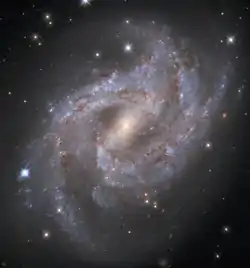| NGC 2525 | |
|---|---|
 NGC 2525 by Hubble Space Telescope | |
| Observation data (J2000 epoch) | |
| Constellation | Puppis |
| Right ascension | 08h 05m 38s[1] |
| Declination | −11° 25′ 37″[1] |
| Redshift | 0.005274 ± 0.000017 [1] |
| Heliocentric radial velocity | 1,581 ± 5 km/s[1] |
| Distance | 71 Mly (21.9 Mpc)[2] |
| Apparent magnitude (V) | 11.6 [3] |
| Characteristics | |
| Type | SB(s)c [1] |
| Apparent size (V) | 2.9′ × 1.9′ [1] |
| Other designations | |
| UGCA 135, MCG -02-21-004, PGC 22721[1] | |
NGC 2525 is a barred spiral galaxy located in the constellation Puppis. It is located at a distance of about 70 million light years from Earth, which, given its apparent dimensions, means that NGC 2525 is about 60,000 light years across. It was discovered by William Herschel on February 23, 1791.[4]
The galaxy has a bar and two main spiral arms with high surface brightness. HII regions are observed in the arms. The brightest stars of the galaxy have apparent magnitude around 22. Its nucleus is small and bright.[5] In the centre of the galaxy is predicted to lie a supermassive black hole whose age is estimated to be between 1.1 and 44 million years, based on the spiral arm pitch angle.[6][7]
SN 2018gv

One supernova has been observed in NGC 2525, SN 2018gv. It was discovered on 15 January 2018 at magnitude 16.5,[8] and it was identified spectrographically as a type Ia supernova 10 to 15 days before maximum.[9] The supernova was also observed by ATLAS on 2018 January 14.5 UT at magnitude 18.1.[10] It reached a peak magnitude of 12.8. A video of the supernova was released.[11][12]
References
- 1 2 3 4 5 6 7 "NASA/IPAC Extragalactic Database". Results for NGC 2525. Retrieved 2016-01-18.
- ↑ Theureau, G.; Hanski, M. O.; Coudreau, N.; Hallet, N.; Martin, J.-M. (19 December 2006). "Kinematics of the Local Universe". Astronomy & Astrophysics. 465 (1): 71–85. arXiv:astro-ph/0109080. doi:10.1051/0004-6361:20066187. S2CID 14251529.
- ↑ "Revised NGC Data for NGC 2525". spider.seds.org. Retrieved 25 November 2018.
- ↑ Seligman, Courtney. "NGC 2525". Celestial Atlas. Retrieved 19 November 2018.
- ↑ Sandage, A., Bedke, J. (1994), The Carnegie Atlas of Galaxies. Volume I, Carnegie Institution of Washington
- ↑ Davis, Benjamin L.; Berrier, Joel C.; Johns, Lucas; Shields, Douglas W.; Hartley, Matthew T.; Kennefick, Daniel; Kennefick, Julia; Seigar, Marc S.; Lacy, Claud H. S. (20 June 2014). "The black hole mass function derived from local spiral galaxies". The Astrophysical Journal. 789 (2): 124. arXiv:1405.5876. Bibcode:2014ApJ...789..124D. doi:10.1088/0004-637X/789/2/124. S2CID 119302157.
- ↑ Treuthardt, Patrick; Seigar, Marc S.; Sierra, Amber D.; Al-Baidhany, Ismaeel; Salo, Heikki; Kennefick, Daniel; Kennefick, Julia; Lacy, Claud H. S. (11 July 2012). "On the link between central black holes, bar dynamics and dark matter haloes in spiral galaxies". Monthly Notices of the Royal Astronomical Society. 423 (4): 3118–3133. arXiv:1204.4210. Bibcode:2012MNRAS.423.3118T. doi:10.1111/j.1365-2966.2012.21118.x.
- ↑ "SN 2018gv". Transient Name Server. wis-tns.weizmann.ac.il.
- ↑ "ATel #11175: Spectroscopic Classification of SN 2018gv with Keck I/LRIS". ATel. 16 January 2018.
- ↑ "ATel #11177: ePESSTO spectroscopic classification of optical transients: SN2018gv a very young SN Ia". ATel. 16 January 2018.
- ↑ "Time-Lapse of Supernova in NGC 2525", European Space Agency, retrieved 2021-11-05
- ↑ NASA, ESA, J. DePasquale (STScI), M. Kornmesser and M. Zamani (ESA/Hubble), A. Riess (STScI/JHU) and the SH0ES team, and the Digitized Sky Survey (6 October 2020). "Check out this exploding supernova captured by the Hubble telescope". CBBC Newsround.
Supernova SN 2018gv
{{cite web}}: CS1 maint: multiple names: authors list (link) CS1 maint: numeric names: authors list (link)
External links
- NGC 2525 on WikiSky: DSS2, SDSS, GALEX, IRAS, Hydrogen α, X-Ray, Astrophoto, Sky Map, Articles and images
- NGC 2525 on SIMBAD